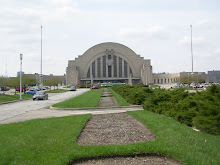On a fairly quiet stretch of West Ninth Street, and a bit removed in my opinion, is the Goodall Building. Located at 324 West Ninth and around the corner from City Hall, the Goodall Building was completed in 1895 and designed by Cincinnati architect George W. Rapp. It is on the National Register of Historic Places but just west of the Ninth Street Historic District.

 Photo of Central Christian Church shows the Goodall Building to the left. (The Children's Home is to the right of the church.)
Photo of Central Christian Church shows the Goodall Building to the left. (The Children's Home is to the right of the church.)I would classify the seven-story building as 2nd Renaissance Revival style. The elegant composition includes a facade in three parts with a clear base, middle and top. The base includes a cast iron facade and yet an off-center entranced framed in sandstone. The middle section includes a wonderful bay window that emphasizes the buildings verticality. The carved stone details, including the grouped pilasters and their capitals, are classically inspired but may be more attributed to Romanesque Revival styles.




Architect George W. Rapp was born February 22, 1851, in Cincinnati. He designed many buildings in his lifetime and was twice the President of the Cincinnati Chapter of the American Institute of Architects (1894-1896; 1907-1908). His body of work includes a number of brewery buildings including the Kaufmann Brewery (now Guildhaus) at 1625 Vine Street, completed circa 1888. He also designed the Kaufmann Building (1876), an apartment building at 1721-1725 Vine Street built by the Brewery. (Kevin at Building Cincinnati has a story on the building's renovation here.) According to the book, Over the Barrel, Volume I, he also designed buildings for the Christian Moerlein, Herancourt, Gambrinus, Gerke, and Windisch-Muhlhauser companies.



Other notable buildings by George W. Rapp include the now demolished Bavaria Building and Highland House (1876) at the top of the Mt. Adams incline. He would eventually form the practice Rapp, Zettel, and Rapp with John Zettel (1881-1950) and his son Walter L. Rapp (1878-1974). Still standing work by the firm prior to George's death include the wonderful Beaux-Arts style German National Bank (1904) on 4th, the Regal Cinema (1908) in the West End, Inwood Park Pavilion (1910), 646 Main Street (1913) and the Le Blond Manufacturing Company (1917) which may have been completed after George's involvement in the firm. Zettel & Walter Rapp would continue the practice, going on to design buildings such as the Mariemont Inn (1929) and the University YMCA (1929). In my opinion, other than the Inwood pavilion, you can see a strong, singular design aesthetic from the firm post turn of the century.





George W. Rapp died January 10, 1918, and is buried in Spring Grove Cemetery, Section 73, Lot 117, Space 4.

I think the Goodall Building is often forgotten that is unfortunate as it is, in my opinion, a handsome early commercial building in the Central Business District. Maybe driving west on Ninth Street after seas of parking lots, it just gets lost. I, for one, hope you find it . . . again or for the first time.
References include:
Clubbe, John. Cincinnati Observed. Columbus, OH: Ohio State University Press (1992)
Holian, Timothy J. Over the Barrel, Volume I. St. Joseph MO: Sudhaus Press (2000)
Historic photos from the Library's Cincinnati Memory Project.
Note: A number of local theatre buildings were designed by Rapp, Zettel, and Rapp but they should not be confused (and I am having trouble keeping them all straight) with the prolific Chicago theatre firm Rapp & Rapp who were George L. Rapp and Cornelius W. Rapp.
.jpg)

2 comments:
Wow Dan...yet another amazing post.
I've always loved that building, esp the first two stories.
Kudos
Thanks!
Post a Comment